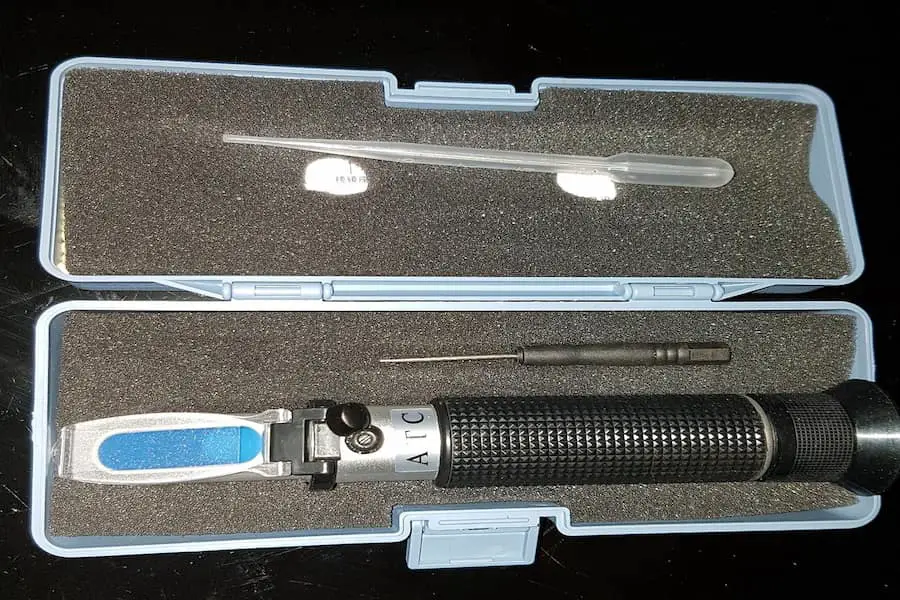If you buy something through a link in our posts, we may get a small share of the sale.
Do you know how to measure alcohol content? It may seem like a difficult task, right? Easy! With the right tools and information, you can do it at home without involving a professional. It is as easy as using a hydrometer or a refractometer.
Contents
How to Measure Alcohol Content
Homebrewers or large-scale distillers use tools such as hydrometers and densitometers to measure the specific gravity and to determine how much alcohol content is in a liquid. They also use a refractometer to measure the refractive index of alcohol to determine how much sugar was converted to alcohol during fermentation.

For homebrewers, a hydrometer is a more important tool to have in their arsenal. By taking a gravity reading before and after fermentation, brewers can calculate their beer’s alcohol by volume (ABV). We can also use a hydrometer to test wort, must, or fruit juice before and after fermentation to determine the alcohol content.
What is Alcohol Content?
The alcohol content is the percentage of ethanol in a liquid by volume. For example, if you have a 5%ABV beer, that means the beer has 5% alcohol by volume.
Alcohol by volume (ABV) and alcohol by proof (ABP) are both ways to measure the alcohol content. ABV is the most common way to measure because it is the percentage of alcohol in a liquid by volume. ABP is less common, and it is the percentage of alcohol in a drink by weight.
The proof of an alcoholic beverage is twice the ABV. So, a liquor with an ABV of 40% has an 80-proof rating. Most countries use ABV to measure the alcohol content, and it is always shown on the label of every bottle or can.
Measuring Alcohol Content Using a Hydrometer
A hydrometer is a simple device made of glass or plastic that measures the density of a liquid. It is a weighted glass tube inserted into a liquid to measure its density. The hydrometer will float higher or lower in the liquid depending on the density of the liquid.
The weight of the object determines the specific gravity of a liquid compared to the weight of an equal volume of water. Liquids with high sugar content, such as syrups, will have higher specific gravity than water. Liquids with high alcohol content, such as liquor, will have lower specific gravity than water.
Brewers use hydrometers to measure the gravity of the wort before and after fermentation. By taking two readings and calculating the difference, they can determine the ABV of their beer.
- Make sure your hydrometer is calibrated. To do this, place it in a container of distilled water and make sure the hydrometer floats at the 1.000 mark on the scale. If it does not, you will need to adjust the calibration.
- Sanitize the hydrometer and your test vessel. You can use ethyl alcohol and a sanitizing agent such as soda ash to do this.
- Take a gravity reading of the wort before fermentation. This is known as the original gravity (OG). Record the OG and the temperature of the wort on your brew sheet.
- Let the wort ferment for the recommended amount of time. For instance, if you are brewing an ale, allow the wort to ferment for two weeks. Record this on your brew sheet.
- Take a gravity reading of the wort after fermentation on the hydrometer scale. This is known as the final gravity (FG). Record the FG and the temperature of the wort on your brew sheet.
- Subtract the final gravity (FG) from the original gravity (OG) to calculate the ABV of your beer in percentage by multiplying it by the standard conversion factor; 131.25.
Here is the formula:
ABV% = Original Gravity (OG)-Final Gravity (FG) *131.25
131.25 is the ABV conversion factor (Multiply the difference by this factor)

Factors to Consider When Using a Hydrometer
I need accurate reading to calculate the ABV of my beer, and a few things can affect the reading. I should consider the following factors to come up with an accurate reading:
- The temperature of the liquid – The temperature of the liquid will affect the object’s weight and, in turn, the specific gravity. Ensure you are taking your readings at the same temperature.
- The size of the container – When taking a reading, make sure the hydrometer is fully submerged in the liquid. If it is not, you will get a false reading.
- Depth of the object in the liquid – The deeper the object is in the liquid, the greater its pressure. This will also affect the weight and specific gravity. Always take your readings at the same depth.
Measuring Alcohol Content Using a Refractometer
A refractometer is a more sophisticated device used to measure the sugar and alcohol content of a beverage. It is a handheld device that uses light to measure the refractive index of a liquid. Brewers use a refractometer to measure the specific gravity and the sugar content of the wort in the brewing process.
The following are the steps to follow:
- Clean the refractometer using a sanitizing agent and make sure it is dry
- Place a few drops of the liquid to be tested on the prism (Alcohol)
- Close the eyepiece and look through it
- Adjust the focus until the image is clear
- Read the refractive index on the scale
- Record the refractive index in a refractometer chart
- Convert the refractive index to sugar or alcohol percentage
Below lists the refractive indices of some common beverages.
- Ethanol 1.36
- Water 1.3
- Beer 1.329-1.473
- Wine 1.495-1.526
Both the Brix scale and Alcohol by Volume ABV% scales are on the refractometer. Be sure to use the correct scale for the measurement you are taking.
Measuring Alcohol Content Using a Pycnometer
A pycnometer is a laboratory device used to measure the density of a liquid. It is a small, cylindrical container with a graduated scale on the side. The Pycnometer measures the density of a liquid, which is then used to calculate the concentration of alcohol in the liquid.
The following are the steps to follow:
- Sanitize the pycnometer and its stopper using sanitizing agents such as soda ash
- Weigh the empty pycnometer
- Weigh the pycnometer and stopper together
- Pour the liquid to be tested into the pycnometer
- Replace the stopper and shake the pycnometer vigorously
- Allow the pycnometer to stand for a few minutes
- Weigh the pycnometer and stopper together again
- Subtract the first weight from the second weight
- The difference is the weight of the liquid
- Divide the weight of the liquid by the volume of the pycnometer to determine the density
- Convert the density to alcohol concentration.
The tool requires much attention and patience while taking readings. Its advantage is that it is more prone to human error compared to the hydrometer.
Measuring Alcohol Content With a Distillation Apparatus
The method is based on the fact that the boiling point of a liquid is lowered as the concentration of alcohol in the liquid increases. The apparatus used for this measurement is called a distillation apparatus.
The apparatus has a pot in which the liquid to be distilled is heated and a condenser coil into which the vapors from the pot are directed. The coil is cooled by running water through it. The condensed liquid, richer in alcohol than the liquid in the pot, is collected in a receiver.
The collected liquid is then measured to determine the alcohol concentration. I can use tools such as a hydrometer or a refractometer to measure the alcohol content.
What to Keep In Mind When Using a Distillation Apparatus
The liquid must be heated evenly. If the liquid is not heated evenly, the more volatile elements, such as alcohol will escape from the pot. The final measurement will be lower than the actual alcohol content.
The temperature of the liquid must be constant. If the temperature varies, the boiling point of the liquid will also vary, and again, the final measurement will be lower than the actual alcohol content.
The apparatus must be leveled. If it is not leveled, the liquid will not boil evenly, which will affect the accuracy of the measurement.

Beer Styles and Their Alcohol Content
The following is a list of some common beer styles and their associated alcohol content:
- Lager- The beverage is made from a bottom-fermenting yeast and has an alcohol content of 3%-9%ABV. It is suitable for drinking with a meal or as a session beer.
- Ale- It is made from top-fermenting yeast and has an alcohol content of 4%-7%. It is fuller-bodied than a lager and best served at room temperature.
- Stout- It is made from top-fermenting yeast and has an alcohol content of 5%-6%ABV. It is a heavier beer with a coffee-like flavor. The beer is best served at room temperature.
- Wine- Wine is made from various fruits, such as grapes, and has an alcohol content that ranges from 8% to 25%ABV. Wine is best served at room temperature.
- Liqueur- Liqueur is a sweet, alcoholic beverage made from distilled spirits and flavoring ingredients. The liqueur has an alcohol content that ranges from 15% to 55%ABV. It is best served chilled.
The Recommended Alcohol Content Intake by WHO
Alcohol abuse has been linked with a number of health problems. WHO recommends alcohol of 2.5% for men and 1.25% for women to reduce diseases such as liver cirrhosis, cancer, and cardiovascular disease. It is important to be aware of the risks associated and reduce the burden from harmful use of alcohol due to alcohol abuse and keep my alcohol intake within the recommended limits.
Frequently Asked Questions
How Do You Measure Alcohol Content Without Hydrometer?
You can measure the alcohol content of a liquid without a hydrometer by measuring the mass of a known volume of the liquid and dividing it by the mass of the same volume of pure water. You can also use distillation or a refractometer.
What Does a Hydrometer Look Like?
A hydrometer is a glass tube that is filled with mercury or alcohol. The lower the specific gravity of the liquid, the higher the hydrometer floats. It is ideal for measuring the specific gravity of fermenting wort, must, or wine.
Can You Test Alcohol Content in the Body?
Yes, you can test the alcohol content in your body by using a breathalyzer. A breathalyzer measures the amount of alcohol in your breath and will give you an estimate of your blood alcohol content.
Conclusion
When it comes to measuring alcohol content, there are many different ways. The most accurate way is to use a hydrometer. However, one can use other methods as well. With a little bit of practice, you can become an expert at measuring alcohol content using any of these methods.

